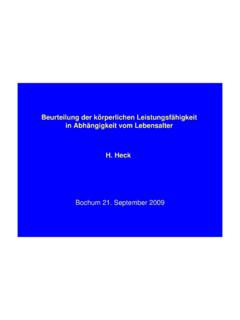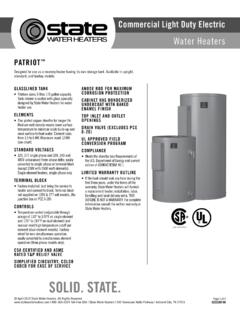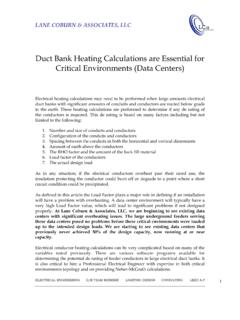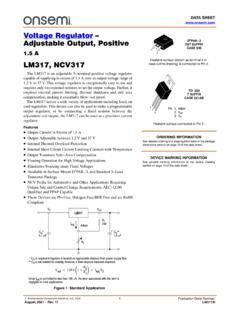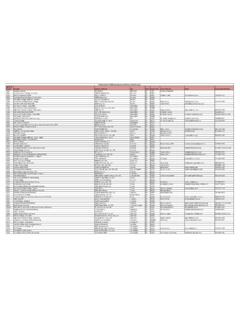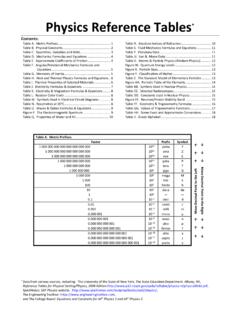Transcription of Iterative calculation of the heat transfer coefficient
1 Progettazione Ottica Roncati Iterative calculation of the heat transfer coefficient Progettazione Ottica Roncati, Ferrara - Italy Aim The plate temperature of a cooling heat sink is an important parameter that has to be determined with accuracy. The estimated value depends on its geometrical shape, on the total amount of energy to be dispersed, and on the air flow. The heat transfer coefficient , h, is the most difficult parameter to be settled. In this report it is shown a fast and easy Iterative method to calculate the h value and later, the temperature of cooling for heat sink. Introduction The heat transfer coefficient or convective coefficient (h), is used in thermodynamics to calculate the heat transfer typically occurring by convection. A simple way to calculate h is to define it through the classical formula for convection, and compare it with a different definition of h, through dimensionless parameters.
2 Unfortunately, even if defined by means of different parameters, both the environment and the heat sink temperature are important to estimate h. An Iterative method is then required, by setting an initial value of the Tp. Convection heat transfer coefficient The formula for heat transfer is: = (1) Where: Q =heat transferred, J/s = W h = heat transfer coefficient , W/(m2 K) S = transfer surface, m2 Tp = Plate temperature, K Ta = Air temperature, K For convection we use the convection heat transfer coefficient hc, W/(m2 K). A different approach is to define h through the Nusselt number Nu, which is the ratio between the convective and the conductive heat transfer : = = ( )/! (2) Where: Nu = Nusselt number hc = convective heat transfer coefficient k = thermal conductivity, W/mK L = characteristic length, m Progettazione Ottica Roncati The convection heat transfer coefficient is then defined as following: =" #$ (3) The Nusselt number depends on the geometrical shape of the heat sink and on the air flow.
3 For natural convection on flat isothermal plate the formula of Na is given in table 1. Table 1: Nusselt number formula. Vertical fins Horizontal fins Laminar flow = )*+.,- Upward laminar flow = )*+.,- Turbulent flow = )*+.00 Downward laminar flow = )*+.,- Turbulent flow = )*+.00 Where: )* = 34 54 (4) is the Rayleigh number defined in terms of Prandtl number (Pr) and Grashof number (Gr). If Ra < 106the heat flow is laminar, while if Ra > 106the flow is turbulent. The Grashof number, Gr is defined as following: 34 =7 $8 9 :;<:= >? (5) Where: g = acceleration of gravity = , m/s2 L = longer side of the fin, m = air thermal expansion coefficient . For gases, is the reciprocal of the temperature in Kelvin: @ =A:=, 1/K Tp = Plate temperature, C.
4 Ta = Air temperature, C = air kinematic viscosity, is 10<- at 20 C. 10<-at 30 C. For plate temperature, Tp, set a expected value. Finally, the Prandtl number, Pr is defined as: 54 =C # (6) Where: = air dynamic viscosity, is 10<- at 20 C. 10<-at 30 C. cp = air specific heat = 1005 J/(Kg*K) for dry air k = air thermal conductivity = W/(m*K) at 27 C Progettazione Ottica Roncati Radiant heat transfer coefficient The total amount of energy leaving a surface as radiant heat depends on the absolute temperature and on the nature of the surface. A non-blackbody, emits radiant energy from its surface at a rate that is given by: E = F G I= F G I I (7) Where F = 10<JKL? MN is the Stefan-Boltzmann constant and is the emissivity.
5 Emissivity varies from 0 (for non emitting body) to 1 (for blackbody). Values of emissivities for aluminum is presented in Table 2. Replacing qof Eq. 7 in we obtain: F G I I = (8) And solving for h obtain the formula for radiant heat transfer coefficient , hr: =O P :;N<:=N :;<:= (9) Table 2. Emissivities of different aluminum surface treatment Aluminum 310 K 530 K 800 K Polished Oxidized 24-ST weathered Anodized (at 1000 F) For not negligible radiation the overall heat transfer coefficient is: = + (10) In Figure 1 are reported the values of hr as a a function of Tp for emissivity of and Ta = 20 C. Fig. 1: Radiant heat transfer coefficient for varies temperature plate with ambient temperature 20 C and emissivity Progettazione Ottica Roncati Iterative method An initial guess value for Tp is set in Eq.
6 5 to determine Gr. Once calculated the dimensionless parameters Gr, Pr, Ra and Nu,the value of h is obtained through the Eq. 3. By introducing the value of h in Eq. 1, a new value of Tp is given by: = +R S (7) and the obtained Tp can be used to estimate iteratively the proper value of Gr for the particular experimental set-up by using it in the Eq. 5. The obtained value of h is then used again to estimate the Gr parameters, in an Iterative way, that rapidly converges to the correct estimation of h. Example 1. A LED is assembled on a 40 x 40 x 6 mm aluminum heat sink with four fins 30 mm long and 4 mm large. The LED generate 3 W and the room temperature is 20 C. Which is the value of the heat sink temperature? Fig. 2 scheme showing the assembled heat sink and energy flow.
7 1. Define Grashof number with L = 40 mm, the greater side of fins and assuming a plate temperature of 100 C: 34 = 9,81 0,040 1273 + 20 (100 20)(1,5 10<-),= 10- 2. Define Prandtl number: 54 =1,81 10<- 10050,026= 3. Define the Rayleigh number: )* = 10- = 10-< 1 106 so is laminar flow. Progettazione Ottica Roncati For laminar flow, horizontal fins (flat and isothermal with good approximation) and heat upward flow, from Table 1 the value of Nusselt number Nu is determined by using the relation: = )*+.,-= ( 10-)+,,-= 4. Finally, the heat transfer coefficient turns out to be: = 0,0260,04= WX, Y 5. The cooling area is the sum of lateral fins surface and the plane surface, as shown in Fig. 3. Fig. 3. Explanation of the dispersion surfaces The total lateral fins surface is: 40 30 8 = 9600 XX,= 0,0096 X,, the plan surface is 40 40 =1600 XX,= 0,0016 X, for a total cooling surface of 0,0112 X.
8 By using the value of the cooling surface, it is possible to check the correctness of the Tp that was initially set to calculate a starting value for Gr (Eq. 5). = 20 [ +3 WX, Y 0,0112 X,= 48 [ As evident, the set and the estimated values of Tp are inconsistent. The calculated value of Tp is used in Eq. 5 to estimate a more appropriate value of Gr. With Tp =48 C, the new parameters are: 34 = 10-, )* = 10-, = , = KL? M. Pr is always 0, with a check the plate temperature result to be = 57 [. Further iterations gets the following values: 1. = KL? M and = 54 [. 2. = KL? M and = 55 [. The last iteration give a values of Tp for both convection heat formula and via Nusselt number. The value of = KL? M can be considered. Progettazione Ottica Roncati If also the flat side of the heat sink is in free air we must add this other convection which has a different h value.]]]]]
9 In the Example 2 such effect is also considered. Example 2. Consider the heat sink in example 1 with heat generated by a 4 x 4 mm LED die set in the middle of the plane as show in figure 4. Define the heat sink temperature, Tp, considering the two different heat transfer coefficients. Example with upward and downward convection The flat surface is 40 40 = 1600 XX, . For the cooling area we must subtract the die area: 1600 16 = 1584 XX,= X,. The Nusselt formula for horizontal flat plate in natural air flow and downward heat flow is: = )*+.,- We have already defined the value for Gr, and Ra with L = 40 mm and Tp = 55 C and can calculate Nu and h: 34 = 10-; )* = 10-, = ; = KL? M. With two different convection coefficient the becomes: =( A A+ , ,) (8) Where the subscript 1 is for upward convection and 2 for downward.
10 Solving for the becomes: = +R ] S]^ ? S? (9) Substituting the values we get: = 20 + + 52 [ For the Iterative method we set Tp = 52 C in to re-calculate Nu and hc for upward and downward convection and set the new Nu and h value in 1. A= KL? M, ,= KL? M, = 53 [ 2. A= KL? M, ,= KL? M, = 53 [ Progettazione Ottica Roncati The last iteration give a values of Tp for both convection heat formula and via Nusselt number. The value of . A= KL? M and ,= KL? M can be considered. Validation of the method The Iterative method was applied to define the heat sink temperature of the LED floodlight SIRIO24 (a new product developed by Progettazione Ottica Roncati and Paolo Colombani Design, see Figure 5). The results of the Iterative method were compare with both the thermal simulation (performed with the finite element analysis software LISA ) and the laboratory tests.]



